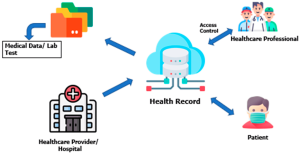Blockchain is revolutionizing how EMR systems manage and share sensitive patient data. This blog breaks down the concept of blockchain data sharing in electronic medical record (EMR) systems, explaining its benefits and impact.
Understanding Blockchain
Imagine a digital ledger that records transactions securely and transparently. That’s blockchain! Unlike traditional databases, where a central authority manages data, blockchain distributes information across a network of computers. Each piece of data called a “block,” is linked in a chain, creating an unalterable record. Blockchain’s strength lies in its tamper-proof nature and decentralized structure.
Enhancing Data Security in EMR Systems
Patient data security is paramount in EMR systems. Blockchain’s encryption and decentralization make it exceptionally secure. Patient records stored in a blockchain are encrypted, ensuring that only authorized individuals can access them. Plus, since data isn’t stored in a single location, hackers find it much more difficult to breach the system.
Transparent Data Sharing Between EMR Systems
Traditional data sharing is complicated and raises concerns about privacy and accuracy. Blockchain simplifies this process by enabling transparent and secure sharing. Authorized parties can access the necessary information in real time without compromising data integrity. This is especially valuable in emergencies or when multiple healthcare providers are involved in a patient’s care.
Consent Management
Blockchain empowers patients to control their data by allowing them the ability to grant and revoke access as needed. With patient consent recorded on the blockchain, healthcare providers have access to the required data while respecting the patient’s privacy preferences. This level of consent management is a significant step forward in patient-centered care.
Streamlined Interoperability in EMR Systems
Interoperability, or the ability of different systems to communicate, is crucial in healthcare. Blockchain simplifies data sharing between EMR systems, labs, pharmacies, and even insurance providers. Instead of relying on complex data exchange protocols, systems securely share data using blockchain, leading to smoother healthcare operations.
Potential Challenges
While blockchain offers promising solutions, there are challenges to consider. Implementation is complex and requires changes to existing systems. Additionally, addressing legal and regulatory issues related to data ownership, consent, and standards is essential for successful blockchain integration.









